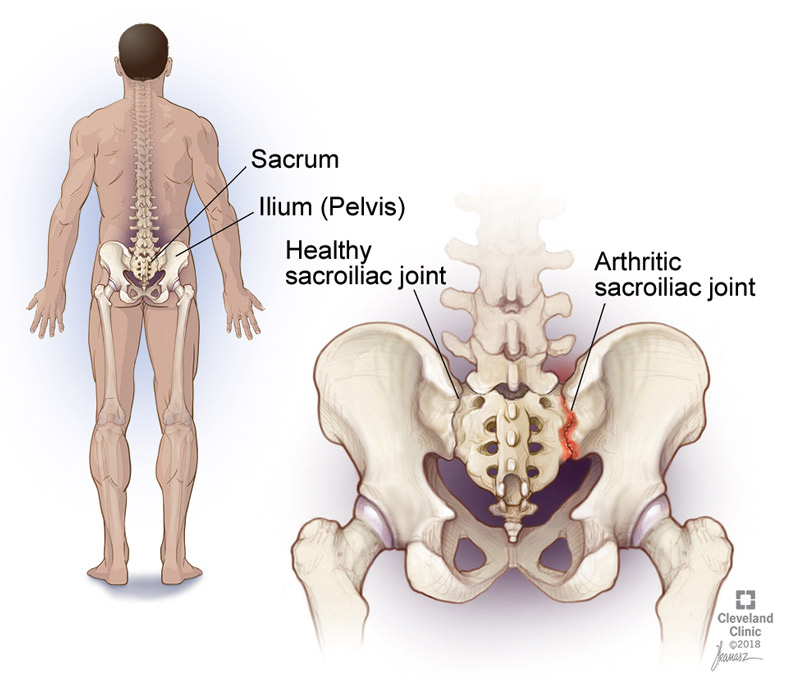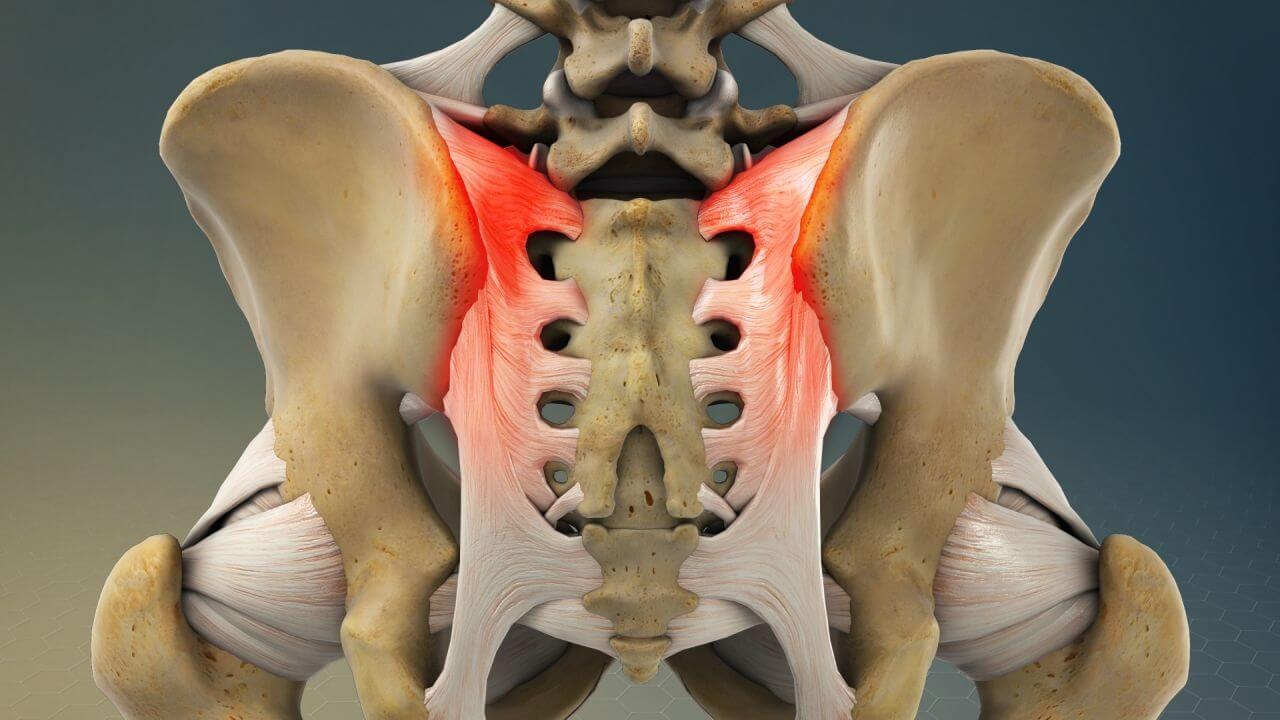Sacroiliac Joint Dysfunction: Sacroiliac (SI) joint dysfunction is a condition that affects the sacroiliac joints, which connect the sacrum (the triangular bone at the base of the spine) to the ilium (the uppermost part of the pelvis). This dysfunction can lead to lower back and leg pain, impacting daily activities and overall quality of life. In this blog, we will delve into the causes, symptoms, and management of SI joint dysfunction, and highlight the expert care available at the KLM Group, led by Dr. Vipin Garg.

Understanding the Sacroiliac Joint
Anatomy of the Sacroiliac Joint
The sacroiliac joints are located on either side of the lower spine, connecting the sacrum to the ilium. These joints play a crucial role in transferring the weight of the upper body to the lower body, providing stability and shock absorption. Unlike other joints in the body, the SI joints have limited movement, primarily functioning to provide stability rather than mobility.

The Role of the SI Joint
The primary function of the SI joint is to absorb and distribute the forces generated during activities such as walking, running, and lifting. This joint helps maintain the stability of the pelvis and lower spine, ensuring proper alignment and movement. Dysfunction in the SI joint can disrupt this balance, leading to pain and discomfort.
Read More:
Causes of Sacroiliac Joint Dysfunction
Traumatic Injury
Traumatic events such as falls, car accidents, or sports injuries can cause damage to the SI joint. This damage can result in inflammation, instability, or misalignment of the joint, leading to dysfunction and pain.
Pregnancy
Pregnancy can put additional strain on the SI joints due to hormonal changes and the increased weight of the growing fetus. The hormone relaxing, which is released during pregnancy, loosens the ligaments in the pelvis to prepare for childbirth, potentially leading to SI joint instability and pain.

Degenerative Conditions
Degenerative conditions such as osteoarthritis can affect the SI joints, leading to wear and tear over time. This degeneration can cause inflammation, pain, and reduced mobility in the joints.
Inflammatory Conditions
Inflammatory conditions such as ankylosing spondylitis or psoriatic arthritis can cause inflammation in the SI joints. These conditions are often associated with chronic pain and stiffness in the lower back and pelvis.
Leg Length Discrepancy
A discrepancy in leg length can alter the alignment of the pelvis and SI joints, leading to uneven stress and potential dysfunction. This condition can be congenital or acquired due to injury or surgery.
Previous Surgeries
Surgeries involving the lower back, pelvis, or hips can sometimes lead to SI joint dysfunction. The altered biomechanics post-surgery can put additional stress on the SI joints, causing pain and instability.
Symptoms of Sacroiliac Joint Dysfunction
Lower Back Pain
One of the most common symptoms of SI joint dysfunction is pain in the lower back. This pain is often localized to one side of the lower back and can range from a dull ache to sharp, stabbing pain.
Buttock Pain
Pain in the buttocks is another common symptom of SI joint dysfunction. This pain can radiate down into the thigh, mimicking sciatica.
Groin and Hip Pain
Some individuals with SI joint dysfunction may experience pain in the groin or hip area. This pain can be exacerbated by activities such as walking, climbing stairs, or standing for prolonged periods.

Leg Pain
Pain from the SI joint can radiate down into the leg, often affecting the outer thigh and sometimes extending to the foot. This referred pain can be mistaken for other conditions such as herniated discs or sciatica.
Stiffness and Reduced Mobility
Stiffness and reduced mobility in the lower back and pelvis are common symptoms of SI joint dysfunction. This stiffness can make it difficult to perform daily activities and affect overall quality of life.
Increased Pain with Movement
Pain from SI joint dysfunction often worsens with specific movements, such as bending, twisting, or transitioning from sitting to standing. Activities that put additional stress on the SI joints, such as running or lifting heavy objects, can also exacerbate the pain.
Diagnosing Sacroiliac Joint Dysfunction
Clinical Examination
A thorough clinical examination is essential for diagnosing SI joint dysfunction. The healthcare provider will assess the patient’s medical history, perform a physical examination, and evaluate the range of motion and tenderness in the SI joints.
Imaging Studies
Imaging studies such as X-rays, MRI, or CT scans can help visualize the SI joints and rule out other potential causes of pain. These imaging techniques can provide detailed information about the structure and alignment of the SI joints.

Diagnostic Injections
Diagnostic injections involve injecting a local anesthetic into the SI joint to determine if it is the source of pain. If the pain is significantly reduced following the injection, it suggests that the SI joint is the primary source of discomfort.
Management of Sacroiliac Joint Dysfunction
Conservative Treatment Methods
Physical Therapy
Physical therapy is a cornerstone of conservative treatment for SI joint dysfunction. A physical therapist can design a personalized exercise program to strengthen the muscles around the SI joint, improve flexibility, and promote proper alignment. Techniques such as manual therapy, stretching, and strengthening exercises can help alleviate pain and improve function.
Medications
Over-the-counter pain medications such as nonsteroidal anti-inflammatory drugs (NSAIDs) can help reduce inflammation and alleviate pain associated with SI joint dysfunction. In some cases, prescription medications may be necessary for more severe pain.
Activity Modification
Modifying daily activities to avoid movements that exacerbate pain can be beneficial. This may include avoiding heavy lifting, reducing high-impact activities, and using proper body mechanics during movements.
Bracing
Wearing a sacroiliac belt or brace can provide additional support and stability to the SI joints. This can help reduce pain and prevent further injury by limiting excessive movement in the joints.

Interventional Treatments
Injections
Corticosteroid injections into the SI joint can help reduce inflammation and provide pain relief. These injections are often guided by imaging techniques to ensure accurate placement.
Radiofrequency Ablation
Radiofrequency ablation (RFA) is a minimally invasive procedure that uses heat to destroy the nerve fibers transmitting pain signals from the SI joint. This can provide long-lasting pain relief for individuals with chronic SI joint dysfunction.
Surgical Options
SI Joint Fusion
In cases where conservative treatments fail to provide relief, SI joint fusion may be considered. This surgical procedure involves fusing the sacrum and ilium to stabilize the joint and reduce pain. Advances in minimally invasive techniques have made SI joint fusion a viable option for many patients with severe dysfunction.

Lifestyle Modifications
Weight Management
Maintaining a healthy weight can reduce the stress on the SI joints and alleviate pain. Weight management through a balanced diet and regular exercise is essential for overall spine health.
Ergonomic Adjustments
Making ergonomic adjustments in the workplace and at home can help reduce strain on the SI joints. This may include using supportive chairs, adjusting desk height, and practicing proper lifting techniques.

Expert Care at KLM Group
Dr. Vipin Garg
Dr. Vipin Garg is a renowned orthopedic specialist with extensive experience in diagnosing and treating spine-related conditions, including sacroiliac joint dysfunction. He leads the KLM Group, a multidisciplinary team dedicated to providing comprehensive care for individuals with spine issues. Dr. Garg and his team offer a personalized approach to treatment, ensuring that each patient receives the best possible care. Address Link: https://g.page/r/CQ0WqKLEXPWeEAE Powered By Argusdna Also for the best, Orthopedic doctor and surgeon in Kolkata visit www.bonedoctorgautam.com
Services Offered by KLM Group
- Diagnostic Evaluations: Utilizing advanced imaging and diagnostic techniques to accurately diagnose SI joint dysfunction and other spine-related conditions.
- Physical Therapy: Personalized rehabilitation programs designed to strengthen the muscles around the SI joint and improve flexibility.
- Pain Management: Comprehensive pain management strategies, including medications, injections, and alternative therapies.
- Minimally Invasive Procedures: Offering minimally invasive surgical options such as radiofrequency ablation and SI joint fusion for patients with severe dysfunction.
- Patient Education: Providing resources and education to help patients understand their condition and make informed decisions about their treatment.
Success Stories
The KLM Group has a track record of successful outcomes in treating SI joint dysfunction. Many patients have experienced significant pain relief and improved quality of life through personalized treatment plans. Testimonials from satisfied patients highlight the compassionate care and expertise of Dr. Vipin Garg and his team.

Conclusion
Sacroiliac joint dysfunction can significantly impact an individual’s quality of life, causing pain and limiting mobility. Understanding the causes, symptoms, and available treatment options is essential for managing this condition effectively. Conservative treatments such as physical therapy, medications, and lifestyle modifications can provide relief for many individuals. In cases where conservative treatments are not sufficient, interventional and surgical options may be considered.
The KLM Group, led by Dr. Vipin Garg, offers expert care for individuals with SI joint dysfunction. Their multidisciplinary approach ensures that each patient receives personalized treatment tailored to their specific needs. If you are experiencing symptoms of SI joint dysfunction, contact the KLM Group today to schedule a consultation and take the first step towards pain relief and improved spine health.
Contact KLM Group
Book Your Consultation
Website: https://tinyurl.com/yyzvwmck
Email: info@klmgrou p.org
Ph: 0751-4000721,Mob: 7804826825 Address: 12, Saraswati Nagar, University Road, Near Silver Estate, Thatipur,
By seeking expert care from the KLM Group, you can take proactive steps towards managing sacroiliac joint dysfunction and improving your overall quality of life.

